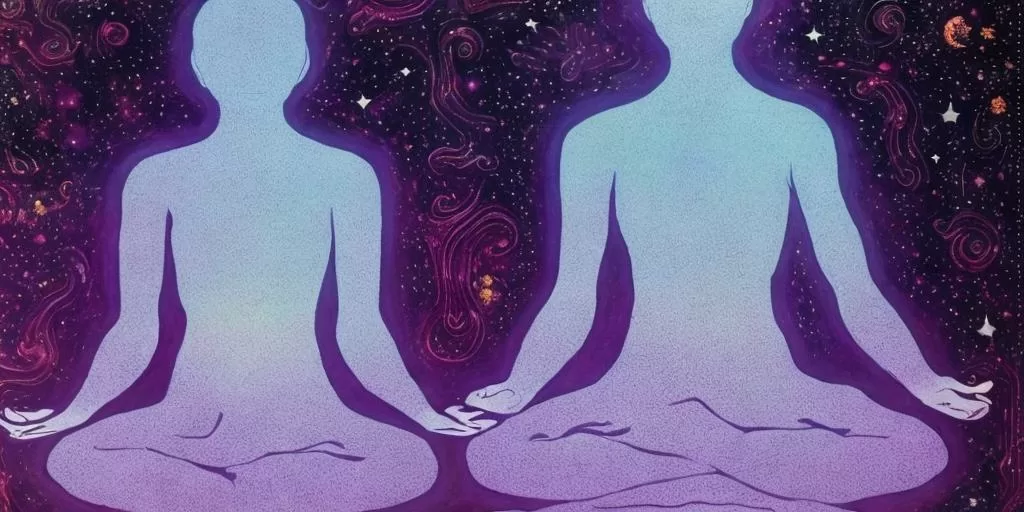Meditation has been gaining popularity in recent times (especially during the lockdown) as an effective way to reduce stress and achieve a greater sense of inner peace. It is a practice that involves focusing the mind on certain objects, sensations, or thoughts with the aim of calming it down and achieving relaxation. This article will outline how meditation can be used as an effective tool for reducing stress levels and promoting feelings of tranquility.
The process of meditating begins with finding a comfortable space where one can put aside all distractions and focus their attention on the present moment. Once settled, the individual should take some slow deep breaths in order to relax their body and clear their mind. Then they can begin to slowly concentrate on whatever object, sensation, or thought they have chosen to focus upon. Through this process, the person’s breathing rate decreases, muscles relax and tension dissipates from both body and mind which leads to increased relaxation.
Regular practice of meditation allows individuals to gain mastery over their mental state by providing them with heightened awareness which increases clarity and encourages healthy thinking patterns; such practices are beneficial not only for physical health but also for emotional well-being too. In conclusion, this article aims to explore these facets in more detail through an examination of the various benefits associated with meditation as a means of attaining relaxation.
Table of Contents
Definition
Meditation is a practice that has been used for millennia to achieve mental clarity and relaxation. It involves focusing one’s attention on an object, phrase, breathing pattern, or activity in order to reach a state of relaxed awareness. This type of meditation can be done while sitting still, lying down, or even walking slowly.
The meaning behind the term “meditation” comes from a Latin word “meditatio” which translates to “to ponder” or “think deeply”. At its core, it is about creating space between thoughts so that one may gain insight into their current situation. The goal is usually to observe without judgment and become more aware of both inner and outer realities. However, bear in mind that there are almost countless forms and variations of meditative techniques that can all serve different purposes. The common meditation definition spread among the general public typically refers to mindfulness meditation which is just one out of many meditation forms.
Meditating regularly will help reduce stress levels by calming the mind, body, and soul. It also encourages positive thinking patterns and brings forth clarity when making decisions. Research suggests that regular meditation can improve concentration as well as physical health overall.
No matter what form of meditation is practiced, there are many benefits to engaging in this practice if done consistently over time; however, each person’s experience with meditation will vary depending on individual goals and preferences.
Transitioning now into the history section…
History

The practice of meditation has been around since the dawn of civilization and its roots can be traced back to many different cultures, religions, and philosophies. While there is no singular origin story for meditation, it’s likely that this mindfulness practice evolved independently in various parts of the world over time.
Here is a timeline overview of key moments in the history of meditation:
- Ancient India – Meditation as an integral part of spiritual life was first developed by Hinduism, Buddhism, Jainism, and other religions originating from ancient India. The Upanishads (a collection of philosophical texts written hundreds of years before the Christ Era) discuss techniques such as breath control, contemplation on mantras or deities, and visualization exercises.
- China & Japan – This Eastern tradition spread further eastward with Taoists integrating elements of Indian yoga into their own philosophy which had already been established in China before 500CE. Zen Buddhism also emerged during this period and heavily influenced Japanese culture.
- Western World – In more recent times, meditation has become increasingly popular among people living in western countries due to its many proven benefits. Famous figures such as Alan Watts have helped introduce eastern philosophies to the west while organizations like Transcendental Meditation have made meditating easier than ever before with practices tailored toward modern lifestyles.
- Modern Day – Today, we are able to access all sorts of helpful resources online to learn how to meditate properly regardless of where one lives or what religion one follows. There are even apps designed specifically for guiding users through each step so anyone can start taking advantage right away!
These days meditation continues to grow in popularity thanks to extensive research showing just how powerful this simple yet effective practice can be when consistently applied over time…
Transitioning now onto exploring some potential benefits associated with regular mediation…
Benefits of Meditation
Meditation is becoming increasingly popular among people looking to improve their physical, mental, and emotional well-being. In fact, a survey conducted by the National Center for Complementary and Integrative Health found that 18 million American adults practice meditation regularly! With such high numbers of practitioners around the world, it’s no wonder why so many are experiencing amazing benefits from this ancient mindfulness practice.
Here are just some potential advantages associated with regular mediation:
- Improved Stress Management – Meditation can be used as an effective tool to help manage stress levels which in turn can lead to improved overall health. Studies have shown that those who meditate on a consistent basis have lower cortisol levels (the hormone responsible for regulating our stress response) than non-meditators.
- Mental Clarity & Focus – Regularly engaging in meditation has also been linked to greater concentration and focus when faced with complex tasks or difficult decisions. This could potentially be attributed to increased activity within certain areas of the brain related to cognitive processing as observed during MRI scans of experienced meditators.
- Emotional Balance – Finally, research suggests that practicing meditation may also aid in maintaining emotional balance due to its ability to cultivate awareness of one’s thoughts and feelings without judgment or attachment. As a result, those who incorporate this exercise into their daily lives often experience more inner peace, joy, and even better relationships with others!
These potential benefits demonstrate how powerful yet accessible meditation really is for individuals looking for ways to enhance their life experiences without any major lifestyle changes.
But how does one get started? Let’s take a look at what steps you can take…
How to Get Started with Meditation
As many have come to discover, meditation is an incredibly simple yet profound practice that can be beneficial for virtually anyone. To help new practitioners get started on their journey of exploration, it’s important to understand the basics of what this ancient art entails and how one can incorporate it into their daily life. Here are some key tips to keep in mind when beginning your meditation practice:
- Set Aside Time – Just like with any other activity or hobby, dedicating a certain amount of time each day for meditation is essential if you want to make progress. For a start, aim for at least 10-15 minutes per session; this will give you enough time to settle into a relaxed state without feeling rushed. As you gain more experience, lengthen the session to about an hour or so.
- Find Your Space – Choose a quiet spot where you won’t be disturbed by outside noise or distractions and try not to move around too much during your session as this can disrupt your focus. If possible, sit comfortably on the floor with crossed legs or use a chair/stool that allows good posture but doesn’t pinch or cause discomfort.
- Focus On The Breath – Now comes the most important part: focusing on the breath! Begin by focusing all attention on breathing naturally and deeply through both nostrils while counting slowly from 1-10 (or higher). This helps bring awareness to the present moment which serves as a great foundation for more advanced techniques down the line.
- Observe Without Judgement – As thoughts arise in your mind while meditating, simply observe them without judgment or attachment so they don’t distract away from the main purpose of being aware of every inhale and exhale. It also helps to cultivate compassion toward oneself during these times since we’re all human after all!
With these basic steps covered, aspiring meditators now have a better idea of how to start building up their skillset in order to gain further insight into themselves and their surroundings.
In the next section, let’s explore different types of meditation techniques available out there today…
Different Types of Meditation Techniques

Modern practitioners of meditation are spoilt for choice when it comes to the types of techniques they can employ. From Vipassana to loving-kindness, or transcendental to Zazen – there is an array of methods that help individuals on their journey to inner peace and stillness.
The most popular technique among beginners is Vipassana, which emphasizes mindful awareness through observation and acceptance. This type of meditation encourages one to observe thoughts without judgment and instead focus on bodily sensations as a way of cultivating self-awareness. As you become more adept at this practice, you will be able to reflect on your experiences in life from an unbiased perspective.
Another common form of meditation is known as loving-kindness (Metta). Here, practitioners use affirmations such as “may I be happy” or “may all beings find peace” in order to cultivate feelings of kindness within themselves and toward others. Unlike other forms where attention is brought inwardly onto oneself, with metta it’s directed outwardly so that those around us may benefit too!
Transcendental Meditation Technique (the trademarked, commercial version) has also been gaining traction recently due to its ability to reduce stress levels while creating positive mental states like happiness and contentment. It involves sitting comfortably in silence while repeating a mantra over and over until one reaches a state of deep relaxation – often referred to as “transcending” thought altogether! Lastly, Zazen is another approach that focuses completely on breathwork by emphasizing long breaths taken deeply into the abdomen with closed eyes; making sure not to control or manipulate them in any way whatsoever.
P.S. Bear in mind that real transcendental meditation (spelled using lowercase letters) is a practice that involves the act of transcendence using various techniques. It could refer to transcending one’s limitations through overcoming selfish needs of the ego by connecting with the universe or overcoming one’s fears to improve performance. The “Transcendental Meditation Technique” is just a fancy (and trademarked) commercial term coined decades ago and the practice relies on chanting a mantra to transcend one’s thoughts and achieve a greater focus, hence it can be classified as simple mantra chanting.
Body scanning is yet another valuable tool used during mediation sessions. By consciously scanning through each part of the body systematically whilst paying close attention to any areas that need special care or attention, we learn how best to move forward mindfully along our paths.
Guided Meditations
Guided meditations are a great way for those new to the practice of meditation to achieve deeper levels of relaxation and stillness. With guided versions, users have access to audio or visual recordings that lead them through the process step-by-step. As these sessions typically come with clear instructions on how to bring the mind into the present moment, they can be particularly beneficial for individuals who may find it difficult to quiet their thoughts without such direction.
In addition to being user-friendly, guided meditations also offer an extra layer of support as they often include calming music and soothing voices which can help relax both body and mind simultaneously. Visualization is another element commonly used in these types of exercises; encouraging participants to focus on positive images while letting go of negative ones – thus allowing space for more feelings of contentment and joy.
The benefits associated with incorporating guided meditations into our daily routines are numerous. Not only do they reduce stress levels but also improve our overall well-being by providing us with a sense of calm and clarity in times when we need it most. This type of mindfulness practice has been linked to improved cognitive function too! By dedicating just 10 minutes each day to this activity, one will likely experience increased motivation, concentration, and memory retention over time.
As seen above, there is much potential for growth when utilizing guided meditations regularly in our lives. Whether drawn by its therapeutic effects or simply seeking greater inner peace – this form of meditation offers something for everyone looking to deepen their connection with themselves and the world around them.
Mindfulness Practices
Mindfulness practices are a powerful tool for cultivating calmness, awareness, and presence in our lives. From the ancient traditions of meditation to modern-day mindfulness techniques, these practices offer us an opportunity to better understand ourselves and find balance in times of chaos. Below is a list of four mindful living activities that can help promote a sense of inner peace:
- Mindful Awareness – It’s easy to get caught up in thoughts about the past or future, but when we practice being aware of what’s happening right now – both internally and externally – it can be easier to remain grounded and present. This type of moment-to-moment monitoring encourages self-reflection and helps bring greater clarity into our lives.
- Meditational Techniques – Meditation has long been used as a way to center oneself amidst life’s distractions. Whether focusing on one’s breath or repeating mantras aloud, this simple yet effective exercise allows us to gain insight into how best to respond rather than react during challenging situations.
- Calmness Techniques – Taking time out each day for relaxation exercises such as deep breathing is key for managing stress levels. Not only do they help reduce tension but also encourage feelings of contentment which often lead to improved decision-making skills over time.
- Self-Inquiry Practices – Asking questions like “What do I need right now?” or reflecting upon values and beliefs can provide invaluable insights into areas where change may be needed for growth. These moments invite an increased level of understanding which can ultimately pave the way toward more meaningful connections with oneself and others.
Through engaging with any (or all!) of the above mindfulness activities, individuals have access to tools that allow them to take back control over their emotions without feeling overwhelmed by external influences. With regular dedication, these practices will not only increase resilience against mental health issues but also create new pathways toward freedom from unnecessary suffering in everyday life.
Stress and Anxiety Relief
Achieving a state of relaxation and mental well-being can seem like an unattainable goal in times of high stress or anxiety. However, with the right tools and techniques, it is possible to create peace within ourselves no matter the external situation. From meditational practices to calming exercises, there are many ways to reduce tension and build resilience against overwhelming emotions.
One such tool for achieving a sense of calm is energy meditation. This meditation involves manipulating one’s energy centers (chakras), energy pathways (meridians), and aura (aka biofield) to restore balance within the mind and body. During this practice, one is encouraged to take slow deep breaths and visualize the flow of energy through the body. This type of meditation has been known to help reduce stress and anxiety, while also promoting relaxation and inner peace.
In addition to meditation, there are other activities that can help promote a relaxed mindset such as Yoga or Tai Chi which involve gentle stretching and movement combined with deep breathing techniques. These types of exercise have been known to improve moods by releasing endorphins – hormones responsible for happiness – into our system while also providing valuable time out from daily stresses.
Another effective way to manage stress levels is progressive muscle relaxation (PMR). PMR involves tensing up each group of muscles individually before consciously relaxing them one at a time until your body feels loose and heavy overall. Practicing this technique regularly allows us to identify areas where tension may be held so that we can proactively loosen those spots throughout the day if needed.
By engaging with any combination of these methods regularly, individuals are able to train their brains into responding differently during times when feeling overwhelmed; thereby creating space between themselves and uncomfortable feelings while still remaining present enough in order to make wiser decisions going forward.
Creating a Home Routine
Meditation is a powerful tool for stress and anxiety relief, with numerous benefits to physical and mental health. While there are many ways to incorporate meditation into our lives, creating a home practice can be an especially useful way of cultivating sustainable relaxation habits. With these four steps, anyone can find their own personal path toward peace and well-being.
Firstly, it’s important to determine which technique or style works best for you – whether that’s breath-focused mindfulness meditation, movement-based yoga or tai chi, sound healing chanting mantras, or any other form that resonates. Once you have identified the approach that will support your needs most effectively, set a regular time when you can commit yourself fully to the practice in order to receive its maximum benefit.
Secondly, establish a comfortable space where you won’t be disturbed during your session; this could be anywhere from a dedicated corner in your room to outside in nature if possible. Additionally, having some kind of ritual before starting to meditate helps signal to your brain that now is the time for stillness and contemplation rather than the fast-paced activities of daily life. This might include lighting a candle or diffusing essential oils such as lavender or sandalwood known for their calming properties or simply taking three deep breaths while silently repeating “I am relaxed”.
Thirdly, experiment with different lengths of sessions according to how much time you have available on any given day – this could range from 15 minutes per session up to 90 minutes or even more depending on what feels appropriate at the moment. Ultimately though consistency is key here so aim to make sure you stick with whatever duration works best for you over time even if it’s just 10 minutes each morning or 3 times throughout the week.
Finally, don’t forget about aftercare: take note of anything positive that arose during your session; reward yourself afterward by doing something enjoyable like reading a book or going for walk; and perhaps discuss any difficulties encountered with someone who understands meditation practices better than yourself such as friends or family members familiar with the process. By following these simple steps we can create our own unique routine tailored specifically toward attaining deeper levels of relaxation while also reaping all its beneficial effects along the way.
Impact On Physical And Mental Health
Gently guiding the mind toward a more relaxed state, meditation has been found to have both physical and mental health benefits. With regular practice, mindful breathing can lower blood pressure, reduce stress hormones and improve overall heart rate variability – just some of its many positive impacts on our physiological well-being. In addition to this, it is also known for its ability to access deeper states of mindfulness which in turn helps cultivate better emotional regulation skills as well as improved concentration levels over time.
As an exercise that focuses on training attention span without judgment or expectations, those who meditate often find themselves less reactive during stressful situations too whilst developing greater self-awareness along the way. Research has even shown how individuals prone to negative thinking patterns may benefit from such practices with reduced rumination leading to enhanced moods in general.
In terms of relaxation however, perhaps one of the most important aspects here is learning how to let go; allowing us to experience moments of stillness when all else seems chaotic in our lives outside these peaceful havens we create for ourselves indoors. While there are no quick fixes nor overnight solutions available, slowly but surely each session provides an opportunity for growth if only we surrender fully to this process and trust what comes up within our own unique journey.
By connecting back into our bodies through simple breath awareness techniques, every moment offers something new – a space where we can rest and recharge before carrying on with whatever life throws at us next; having gained not just insight but strength from embracing this inner wisdom that lies dormant within us all.
Summary

Meditation has been practiced for millennia and is a proven method to relax the mind, body, and soul. Its effects have a wide-reaching impact on physical and mental health as well as providing relief from stress and anxiety. By creating your own home practice you can reap all the benefits of meditation without ever needing to leave your house. It’s no exaggeration that if meditation was available in pill form it would be one of the most sought-after medications around!
The power of relaxation through meditation should never be underestimated. Not only does it provide instant gratification but its long-term effects cannot be overstated enough; melting away tension and allowing us to truly revel in peace and tranquility. We don’t need expensive retreats or fancy yoga classes when we’ve got meditation at our fingertips!
With just 10 minutes a day, anyone can create their own personal oasis of calmness where they can go whenever life gets too much. In this era, more than ever before, having access to such an incredible tool is invaluable – so why not give it a try? Meditation is free, easy to learn, and requires no prior knowledge or experience, plus there are countless resources available online which makes getting started easier than ever before.




